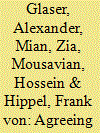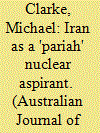|
|
|
Sort Order |
|
|
|
Items / Page
|
|
|
|
|
|
|
| Srl | Item |
| 1 |
ID:
132781


|
|
|
|
|
| Publication |
2014.
|
| Summary/Abstract |
Iran is negotiating with a group of six states over the future of its nuclear program. In November 2013, Iran and the P5+1 (China, France, Germany, Russia, the United Kingdom, and the United States) agreed to a Joint Plan of Action that seeks to reach a "comprehensive solution" by July 20, 2014.
The goal is an agreement on a set of measures that can provide reasonable assurance that Iran's nuclear program will be used only for peaceful purposes and enable the lifting of international sanctions imposed on Iran over the past decade because of proliferation concerns.
A key challenge is to reach agreement on limiting Iran's uranium-enrichment program, which is based on gas centrifuges, in a way that would enable Iran to meet what it sees as its future needs for low-enriched uranium (LEU) fuel for nuclear research and power reactors while forestalling the possibility that this program could be adapted to quickly produce highly enriched uranium at levels and in amounts suitable for use in nuclear weapons
|
|
|
|
|
|
|
|
|
|
|
|
|
|
|
|
| 2 |
ID:
127071


|
|
|
|
|
| Publication |
2013.
|
| Summary/Abstract |
This article demonstrates that Iran conforms to Richard K. Betts' model of a 'pariah' nuclear aspirant, as its nuclear program is driven by a potent combination of security, normative and domestic political motivations. The regime's commitment to its nuclear program is influenced by Iran's long-standing sense of vulnerability to both regional and international adversaries, and an enduring sense of national humiliation at the hands of foreign powers, in parallel with a powerful belief in the superiority of Persian civilisation. This has resulted in the development of a narrative of 'hyper-independence' in Iran's foreign policy that simultaneously rejects political, cultural or economic dependence and emphasises 'self-reliance'. The presumed security benefits that a nuclear weapons option provides are seen as ensuring Iranian 'self-reliance' and 'independence'. This suggests that current strategies that focus exclusively on Iran's security motivations or on a heightened regime of sanctions are fundamentally flawed, as they fail to recognise the mutually reinforcing dynamic between Iran's security and normative/status-derived nuclear motivations
|
|
|
|
|
|
|
|
|
|
|
|
|
|
|
|
| 3 |
ID:
127857


|
|
|
|
|
| Publication |
2013.
|
| Summary/Abstract |
In February 1993, Russia and the United States signed an agreement on the disposition of highly enriched uranium (HEU) extracted from Russian nuclear weapons.[1] Under the terms of the deal, Russia undertook to down-blend 500 tons[2] of HEU, enough to build 20,000 nuclear warheads, over a 20-year period. The two sides agreed that the resulting low-enriched uranium (LEU) would be used as fuel by nuclear power plants in the United States, hence the informal name of the program, "Megatons to Megawatts."
In January 1994, Russia's Techsnab-export (Tenex) and the United States Enrichment Corporation (USEC), the state-run companies authorized by their respective governments to implement the deal, signed the contract. In the U.S. case, that meant that USEC was a supplier of enriched uranium to private utilities. According to assessments made at the time, the value of the entire program was expected to reach about $12 billion.
|
|
|
|
|
|
|
|
|
|
|
|
|
|
|
|
|
|
|
|
|